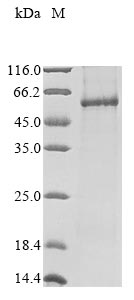This recombinant HumanNOX1 protein is an in vitro E.coli (cell-free) expressed Full Length protein. Its purity is 85%+ determined by SDS-PAGE. Cell-free protein expression is the in vitro synthesis of a protein using translation-compatible extracts of whole cells. In principle, whole-cell extracts contain all the macromolecules and components needed for transcription, translation, and even post-translational modification. These components include RNA polymerase, regulatory protein factors, transcription factors, ribosomes, and tRNA. When supplemented with cofactors, nucleotides, and the specific gene template, these extracts can synthesize proteins of interest in a few hours.
NOX1 is predominantly expressed in colon epithelium and helps to maintain the epithelial barrier and mucosal homeostasis, as well as promote wound healing in the intestinal mucosa by activating focal cell-matrix adhesion proteins and cell motility. NOX1 exerts roles during tissue damage and repair primarily through the modulation of the function of repair cells, including epithelial cells, fibroblast cells, endothelial cells, and smooth muscle cells. It contributes to the rapid generation of ROS in response to IL-13 and interferon-gamma stimulation in human intestinal epithelial cells. NOX1 and its production ROS further take part in intracellular signaling processes regulating the expression of genes that are involved in cell proliferation, differentiation, and tissue repair.






